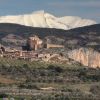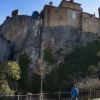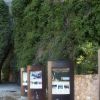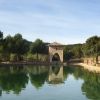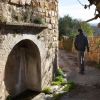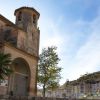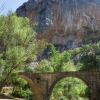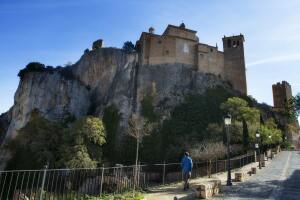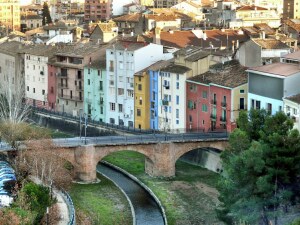The proud Collegiate Castle of Santa Maria la Mayor rises from the deep ravines of the Sierra of Guara, which have been patiently sculpted over time by the waters of the River Vero. At the foot of the castle lie the labyrinthine medieval streets of the historic village of Alquézar, which has deservedly been declared a Site of Historic-Artistic Significance.
Rock, water, history, art and legend: these individual characteristics have merged together in Alquézar, a village that surprises the visitor with its unique atmosphere. To walk the historic streets; to cross beneath the archways of the old walls; to listen to ancient tales of Moors and Christians: is to step back in time and relive history.
The village of Alquézar is situated in the final stretch of the River Vero canyon, in a particularly picturesque setting. It offers a multitude of options for nature lovers and adventure-sport enthusiasts - pot holing, rock-climbing, horse-riding and bicycle routes to name a but a few.
The sport of canyoning in particular is associated with Alquézar. It involves a combination of climbing, abseiling and wading down water-filled canyons – not for the faint hearted! The gentler pastime of hiking is also hugely popular, and there is one notable trail that merits a special mention. It leaves from the Monchirigüel fountain in the centre of the village and descends down through the canyon of La Fuente, allowing walkers to experience the final section of this majestic gorge first-hand. Following this same path, it is possible to discover springs, waterwheels, dams and bridges. These man-made structures all illustrate the importance of the water from the River Vero: a resource that has been used in Alquézar since medieval times.
From Alquézar one can also visit the prehistoric cave paintings of Quizáns and Chimiachas.
Viewpoint “Smile to the Wind”:
This viewpoint provides the first wondrous sight of the historic village of Alquézar, set against the final section of the canyon. The turquoise waters of the River Vero are ever present as they continue their journey from the mountains of Guara to the fertile and sweet lands of the plains below.
On the highest point of a solitary rock, a place surrounded by deep ravines, an unassailable stronghold was built by the Christian kings. The original Moorish castle that once stood on this site was constructed at the beginning of the 9th century on the orders of Jalaf ibn Rasid. His aim was to prevent the Christian forces from the neighbouring county of Sobrarbe entering into Barbitanya. However, Alquézar was finally conquered by the Christians in the 11th century. Over the centuries, the mountains of the pre-Pyrenees have represented a true barrier between these two cultures and religions. The name “Alquézar” actually originates from the Moorish name of “al-Qasr” meaning fortress.
Once King Sancho Ramírez had gained power of Alquézar in 1067, the slopes of the castle began to welcome new inhabitants. However, the repopulation did not begin in earnest until the year 1100, the year that the city of Barbastro also passed into the hands of the Christian kings. The layout of the new village of Alquézar was designed to adapt to the varying levels and curves of the land, and to protect it from the most extreme climate changes. The original medieval layout has been kept until the present day.
Gothic doorway:
The village originally had three gateways providing access to the interior of the urban enclosure, but only one remains: a beautiful Gothic entrance. The doorway is unusual as at one end it was built with a smooth semi-circular arch, whilst at the other end a pointed arch was created, crowned by the coat-of-arms of the village. This shows three towers of a single castle, a design that commemorates the military origins of the town.
Beneath the covered passageway is the entrance to the house of El Médico, where one of the oldest coats-of-arms in Alquézar is displayed. Its age can be ascertained due to the moulding of Gothic appearance and the lack of ornamental details popular in later years. It shows the bars of Aragon, a ‘rampant’ lion with claws spread in attack, and surprisingly, a shell next a pilgrim's staff.
Pedro Arnal Cavero Street:
Once known as Calle Mayo (Main Street), this is the very heart of medieval Alquézar and a walk along this particular street takes the visitor into the historic depths of the village. It is one of three main streets that run lengthways through the village, between which many smaller streets and passageways branch off and connect, allowing easy access to all parts of town.
Several “callizos,” or covered passageways above the streets are still in existence. These are evidence of the necessity to make use of every bit of available space in a village that was once densely populated. It is said that it used to be possible to cross from one end of Alquézar to the other without once stepping on the street.
The architecture of the houses brings together stone, brick and a clay-like material used to build walls (tapial.) This highlights the clever use of local materials, which were easily taken from the plains and the mountains nearby.
A multitude of details await discovery in these narrow paved streets.
Chapel of Our Lady of Nieves:
The small chapel of Our Lady of Nieves is found in Pedro Arnal Cavero Street, just before reaching the main square. This chapel has a single nave with three tracts, covered with a star-shaped ribbed vault, and housing a small altar. The altar is a mixture of Renaissance and Gothic designs, due to the fact that it was put together using various pieces of previous altars. The facade was built by stonemasons in the 17th century following a model of popular religious architecture of the time.
Next to the chapel there is an ancient doorframe, no longer in use, with the silhouettes of two shoes. It has been suggested that could have once been a shoemaker’s workshop, although this is unconfirmed.
The Main Square:
Set in the very heart of the village of Alquézar, the old Main Square is today known as the square of Mosén Rafael Ayerbe. This important historical figure was a priest in the village at the beginning of the 20th century. He achieved fame for creating a new strain of almond tree better adapted to the climatic conditions of the area, from which a variety of almond called "largueta" or "desmayo" is harvested.
It is a beautiful and secluded square surrounded by an arcade, with a harmonious blend of semi-circular arches and straight passageways. Local merchants once came here to sell a variety of produce from the plains and mountains: these days, a weekly market is still held. Permission for an annual fair was first granted by Carlos V in the year 1528, and has been held in the square every year since. That year marked the start of a prosperous new era for Alquézar.
Monchirigüel Fountain:
After crossing the Main Square and continuing along Calle de las Iglesias (Church Street), a small street to the left leads to a flight of stone stairs. These steps lead down to the Monchirigüel Fountain.
It was built in the 16th century and proudly displays the Alquézar coat-of-arms and elements of Renaissance decoration.
From this point, there is a wonderful view of the Collegiate Castle of Santa Maria rising from the hard rock, in apparent defiance of the deep void beneath.
Cruz de Buil Square:
Calle de las Iglesias (Church Street) eventually converges with two other streets, creating the square known as the Plaza Cruz de Buil. Access to the walled enclosure of the collegiate castle can be gained from this square, by passing through an emblazoned entrance built between the 15th and 16th centuries. This entrance has always been the only means of penetrating the enclosure as the castle is surrounded by vertical walls of hard rock.
Viewpoint “O’Bicón”:
Alquézar is surrounded by breathtaking scenery, as the view from the “O’Bicón” viewpoint highlights. To reach this magnificent spot, take Calle Baja from the Cruz de Buil Square.
The view takes in the last stretch of canyon and the mighty River Vero on its journey down from the Pyrenees. It is possible to clearly distinguish the differences in the limestone and conglomerate rocks of the canyon, each having their own distinct characteristics.
The power of the surging waters flowing through the bottom of the ravine was once used to move the turbines of an old hydroelectric plant, and also to move the heavy stones of the Fuentebaños mill downstream.
The sound of the Vero as it passes over rocks is ever present in this beautiful corner of Somontano.
Parish Church of San Miguel Arcángel:
The parish church of San Miguel the Archangel is situated at the far end of town. Construction commenced in 1681 on top of the ruins of a previous church, and the building was eventually completed in 1708.
It is a building of popular design, which stands out for its simplicity and strength. It is made up of a number of different sections and features several small tiled roofs. The baroque nature of the church is hard to discern from the outside, however, the style become more noticeable inside the building. The nave is covered with a barrel vault and the semi-circular decorations are distinctly baroque in nature. Practically the whole of the altar and many other religious artefacts were destroyed in the Spanish Civil War, which helps to explain the scarcity of the interior decoration. Only the top part of the baroque main altar has remained.
Collegiate church of Santa María la Mayor:
The atrium that provided access to the Romanesque temple still remains and is now integrated into the cloister. The capitals date back to the 12th century and reproduce scenes from Genesis. The walls are decorated with murals that date back to the 14th – 18th centuries.
The chapel of Santa Ana, which opens up to the cloister, is a faithful reflection of the melting pot of cultures found in Somontano in the 16th century. Its facade, richly decorated with stucco, boasts a variety of
Gothic, Mudejar and Renaissance elements.
In the 16th century the cloister was extended with the construction of a second floor. One of the rooms was once used as accommodation for residing canons and is now home to some excellent pieces, which make up the Collegiate Church Museum.
A beautiful Gothic facade gives way to the interior of the impressive 16th century church. The star shaped groin vaults that cover the nave highlight the rich decorative style of the internal architecture.
The main altarpiece reflects 16th century Renaissance style and was designed as a holy monument, as the Blessed Sacrament was permanently displayed behind the central oculus. In addition, the 17th century Baroque Chapel of the Lecina houses an almost lifesize Romanesque figure of Christ.
In the 17th and 18th centuries music played an important role in celebrations and religious ceremonies and the rich sounds of the Baroque organ brought depth and magnificence to any occasion.
Ethnological Museum Casa Fabián:
Strolling through the rooms of a 17th century house with its courtyard, kitchen, bedchambers and cellars, immerses visitors in the way of life of the inhabitants of Somontano in the mid 20th century.
Around Alquézar, there are diferent walking routes as:
- Route of Chimiachas
- Route of Pasarelas
- Somontano Nature Route
In Alquézar, you can play other activities like climbing and canyoning, too.



